JAGUAR’S CHALLENGE E-type Meets F-type
Octane Magazine June 2014
Reproduced with permission of Octane magazine (June 2014)
JUST OUR TYPE
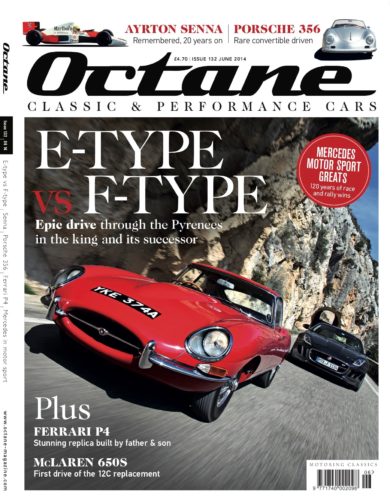
Octane
June 2014
Jaguar’s E-type was born nearly 50 years ago and died nearly 40 years ago. Is there now a worthy successor at last? Octane travels to Barcelona to find out.
EARLY MORNING, TRAVELLING along a deserted motorway a couple of hours from Barcelona, surrounded by fields whose green hue is already fading under the onslaught of spring sunshine, mist clearing from the rocky crags of distant Aragon mountains. Serenely beautiful, both the view and the atmosphere within this 1963 Jaguar E-type 3.8 coupé. Hard to believe it’s more than 50 years old, so capable is it of munching miles at high speed.
It puts you in mind of the heroic dashing to Geneva back in 1961 by Norman Dewis and Bob Berry, for the E-type’s launch; also the high-speed testing carried out by motor manufacturers on public roads in those days. Impossible today; no stretch of UK motorway could ever be so empty as this one. Ten-past-eight, close to a regional airport, and the E-type is one of only two cars on it. The other is the new F-type coupé, which we’ll come to shortly.
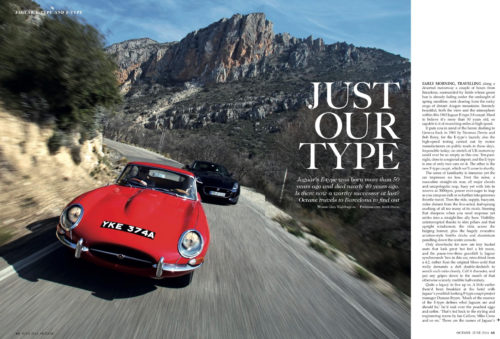
Octane – June 2014
E-type YKE 374A vs F-type
Pages 064 & 065
The sense of familiarity is immense yet the car impresses no less. First the noise, a masculine straight-six roar, all major chords and unapologetic rasp, busy yet with lots in reserve at 3,000 rpm, power ever-eager to leap as you creep an inch or so further into generous throttle travel. Then the ride, supple, buoyant, miles distant from the live-axled, leaf-sprung crashing of all too many of its rivals. Steering that sharpens when you need response yet settles into a straight-line ally here. Visibility uninterrupted thanks to slim pillars and that upright windscreen; the vista across the bulging bonnet, plus the hugely evocative aviation-style Smiths clock and aluminium panelling down the centre console.
Only drawbacks for now are tiny bucket seats that look great but feel a bit mean, and the pause-two-three gearshift (a Jaguar synchromesh ‘box in this car, retro-fitted from a 4.2, rather than the original Moss unit) that really demands a deft double-declutch to snatch each ratio cleanly. Call it character, and put any gripes down to the march of that otherwise scarcely credible half-century.
Quote a legacy to live up to. A little earlier there’d been breakfast at the hotel with Jaguar’s youthful-looking F-type coupé project manager Duncan Bryan. ‘Much of the essence of the E-type defines what Jaguars should be,’ he’d said over the poached eggs and coffee. ‘That’s fed back to the styling and engineering teams by Ian Callum, Mike Cross and so on.’ Those are the names of Jaguar’s design director and chief engineer, vehicle integrity. So can the new F-type coupé reflect that impeccable heritage?
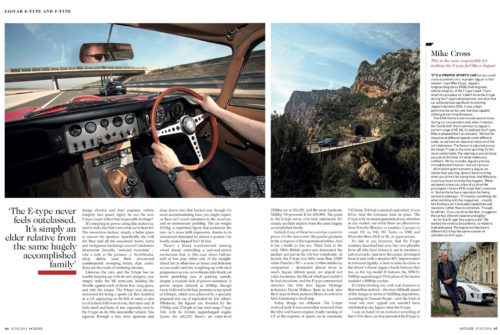
Octane – June 2014
E-type YKE 374A vs F-type
Pages 066 & 067
It’s tempting to power along this motorway until it ends, but that’s not what we’re here for. The mountains beckon, simply a better place to answer the question. Specifically, the Coll del Bruc and all the associated twists, turns and vertiginous backdrops around Catalonia’s Montserrat (literally ‘serrated mountain’ – take a look at the pictures…). Switchbacks, steep climbs, (and their downward counterparts), sweeping bends, dips, crests: these are the roads of motoring nirvana.
Likewise the cars, and the E-type has no trouble keeping up with its new progeny; you simply stroke the XK twin-cam, holding the throttle against each of those four long gears, and ride the torque. The E-type was always renowned for being a sports car that doubled as a GT car, appearing on the bill of many a race too (Graham Hill won in one, first time out). It feels small and looks it, too, especially next to the F-type on its 19 in steamroller wheels. You squeeze through a tiny door aperture and drop down into that bucket seat, though it’s more accommodating than you might expect, as there isn’t much substance to the structure, and no unnecessary padding. The car weighs 1,219 kg, a supermini figure that undercuts the new car’s mass (still impressive, thanks to its aluminium structure) by almost a quarter. I’m hardly snake-hipped but I fit fine.
There’s a broad wood-rimmed steering wheel ahead. Controlling a rack-and-pinion mechanism that, in this case, relays half-an-inch of free play either side of the straight-ahead but is otherwise as linear and feelsome as you could wish for, weighing up with ideal progression as you carve deeper into bends yet never punishing you at parking speeds, despite a resolute lack of power-assistance. A power output claimed as 265 bhp, though rarely believed to be that, promises a top speed of 150 mph, which was achieved by a specially prepared test car, if replicated by few others. Whatever; the figures are dwarfed by the 375 bhp and 171 mph of our mid-range F-type V6S, with its 3.0 litre supercharged engine (yours for £60,235; there’s an entry-level 335 bhp car at £51,235, and the more hardcore, 542 bhp V8-powered R for £85,000). The point is, the E-type never, ever feels outclassed. It’s simply an elder relative from the same hugely accomplished family.
Indeed, if any of these two cars has a point to prove, it’s the newcomer: the gauche graduate in the company of the experienced retiree. And it has a battle to face too. Think back to the early 1960s. British sports cars dominated the market, not just in the UK but worldwide. At launch, the E-type cost little more than £2,000 while Porsche’s 911 – a mere 2.0 litre tiddler by comparison – demanded almost twice as much. Jaguar offered speed, sex appeal and value for money, the like of which just couldn’t be had elsewhere, and the E-type commanded attention like little else. Jaguar Heritage technician David Withers (here to look after the E-type in these pictures) likens its arrival to Neil Armstrong’s small step.
Today things are different. The E-type evolved until it was somewhat removed from the lithe and lissom original, finally turning all GT at the expense of sports car in automatic V12 form. If it had a musical equivalent, it was Elvis. And the Germans took its place. The F-type is by no means guaranteed any attention in any market, not while there are alternatives from Porsche (Boxster vs roadster, Cayman vs coupé, 911 vs V6S, 911 Turbo vs V8R) and Mercedes-Benz (SLK or SL, as appropriate).
It’s fair to say, however, that the F-type roadster, launched last year, has won plaudits from all who have driven it, not to mention a raft of awards. And now the coupé, developed from it and with a massive 80% improvement in torsional rigidity, is here to stake its claim as the driver’s choice. Jaguar clearly believes that too, as the top model R features the XFR-S’s 542 bhp supercharged V8 in place of the fastest roadster’s 488 bhp version.
It’s better looking too, with real character in that roofline and tail – the most difficult aspect of the design in terms of fulfilling regulations, according to Duncan Bryan – and the kind of ‘want one now’ appeal you couldn’t have attributed to any Jaguar since the E-type.
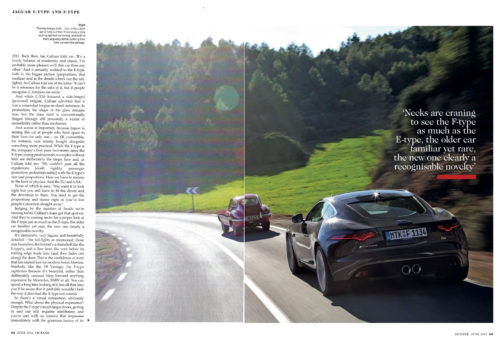
Octane – June 2014
E-type YKE 374A vs F-type
Pages 068 & 069
I was on hand for the exclusive unveiling of the C-X16 show car that preceded the F-type in 2011. Back then, Ian Callum told me ‘It’s a lovely balance of modernity and classic. I’m probably more pleased with this car than any other.’ And it certainly nodded to the E-type, both in the bigger picture (proportions, that roofline) and in the details (check out the tail-lights). As Callum told me of the latter: ‘It can’t be a reference for the sake of it, but if people recognise it, it makes me smile.’
And while C-X16 featured a side-hinged (powered) tailgate, Callum admitted that it was a somewhat tongue in cheek reference. In production, the shape of the glass remains true, but the door itself is conventionally hinged (though still powered), a victim of accessibility rather than mechanics.
And access is important, because Jaguar is aiming this car at people who have space in their lives for only one, an XK convertible, for instance, was mainly bought alongside something more practical. While the F-type is the Company’s first pure two-seater since the E-type, young professionals or couples without kids are deliberately the target here and, as Callum told me: ‘We couldn’t pass all the regulations [crash rigidity, passenger protection, pedestrian safety] with the E-type’s size and proportions. Here we have to answer to the laws of physics. And the EU and USA.’
Judging by the number of heads we’re turning today, Callum’s team got that spot-on. And they’re craning necks for a proper look at the F-type just as much as the E-type, the older car familiar yet rare, the new one clearly a recognisable novelty.
It’s distinctive, very Jaguar, and beautifully detailed – the tail lights as mentioned; those rear haunches; the bonnets a clamshell like the E-type’s and a line from the vent below its trailing edge leads into (and then fades out along) the door. This is the confidence of form that has caused lust for modern Aston Martins. Similarly, like the V8 Vantage, the F-type captivates because it’s beautiful, rather than deliberately unusual (step forward anything expensive by Mercedes, BMW et al). You can spend a long time looking at it, but all that time you’ll be aware that it probably wouldn’t look the way it does had the E-type not existed.
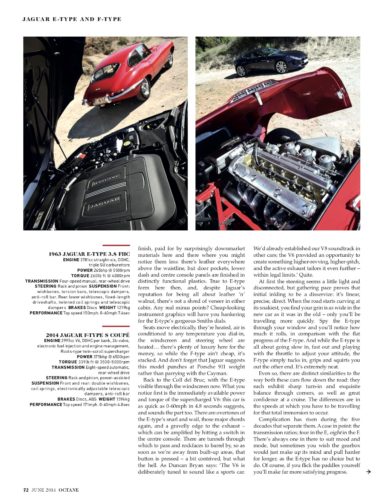
Octane – June 2014
E-type YKE 374A vs F-type
Page 072
So there’s a visual connection, obviously enough. What about the physical experience? Despite the F-type’s much larger doors, getting in and out still requires nimbleness and you’re met with an interior that impresses immediately with the generous luxury of its finish, paid for by surprisingly downmarket materials here and there where you might notice them less: there’s leather everywhere above the waistline, but door pockets, lower dash and centre console panels are finished in distinctly functional plastics. True to E-type form here then, and, despite Jaguar’s reputation for being all about leather ‘n walnut, there’s not a shred of veneer in either cabin. Any real minus points? Cheap looking instrument graphics will have you hankering for the E-type’s gorgeous Smiths dials.
Seats move electrically, they’re heated, air is conditioned to any temperature you dial-in, the windscreen and steering wheel are heated… there’s plenty of luxury here for the money, so while the F-type ain’t cheap, it’s stacked. And don’t forget that Jaguar suggests this model punches at Porsche 911 weight rather than parrying with the Cayman.
Back to the Coll del Bruc, with the E-type visible through the windscreen now. What you notice first is the immediately available power and torque of the supercharged V6; this car is as quick as 0-60 mph in 4.8 seconds suggests, and sounds the part too. There are overtones of the E-type’s snarl and wail, those major chords again, and a gravelly edge to the exhaust – which can be amplified by hitting a switch in the centre console. There are tunnels through which to pass and rockfaces to barrel by, so as soon as we’re away from built-up areas, that button is pressed – a bit contrived but what the hell. As Duncan Bryan says: ‘The V6 is deliberately tuned to sound like a sports car. We’d already established our V8 soundtrack in other cars; the V6 provides an opportunity to create something higher-revving, higher-pitch, and the active exhaust tailors it even further – within legal limits.’ Quite.
At first the steering seems a little light and disconnected, but gathering pace proves that initial inkling to be a disservice: it’s linear, precise, direct. When the road starts curving at its snakiest, you find your grin is as wide in the new car as it was in the old – only you’ll be travelling more quickly. Spy the E-type through your window and you’ll notice how much it rolls, in comparison with the flat progress of the F-type. And while the E-type is all about going slow in, fast out and playing with the throttle to adjust your attitude, the F-type simply tucks in, grips and squirts you out the other end. It’s extremely neat.
Even so, there are distinct similarities to the way these cars flow down the road: they each exhibit sharp turn-in and exquisite balance through corners, as well as great confidence at a cruise. The differences are in the speeds at which you have to be travelling for that total immersion to occur.
Complication has risen during the five decades that separate them. A case in point: the transmission ratios: four in the E, eight in the F. There’s always one in there to suit mood and more, but sometimes you wish the gearbox would just make up its mind and pull harder for longer, as the E-type has no choice but to do. Of course, if you flick the paddles yourself you’ll make far more satisfying progress.
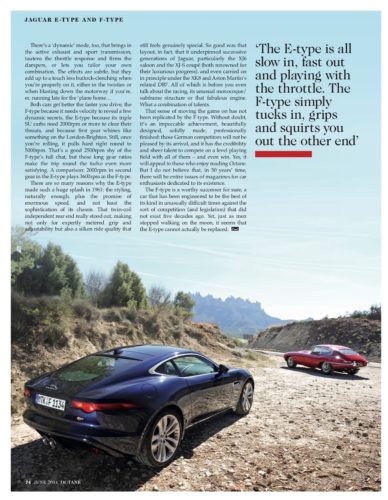
Octane – June 2014
E-type YKE 374A vs F-type
Page 074
There’s a ‘dynamic’ mode, too, that brings in the active exhaust and sport transmission, tautens the throttle response and firms the dampers, or lets you tailor your own combination. The effects are subtle, but they add up to a touch less buttock-clenching when you’re properly on it, either in the twisties or when blasting down the motorway if you’re er, running late for the ‘plane home…
Both cars get better the faster you drive, the F-type because it needs velocity to reveal a few dynamic secrets, the E-type because its triple SU carbs need 2,000 rpm or more the clear their throats, and because first gear whines like something on the London-Brighton. Still, once you’re rolling, it pulls hard right round to 5,000 rpm. That’s a good 2,500 rpm shy of the F-type’s full chat, but those long gear ratios make the trip round the tacho even more satisfying. A comparison: 2,000 rpm in second gear in the E-type plays 3,600 rpm in the F-type.
There are so many reasons that the E-type made such a huge splash in 1961: the styling, naturally enough, plus the promise of enormous speed, and not least the sophistication of its chassis. That twin-coiled independent rear end really stood out, making not only for expertly metered grip and adjustability but also a silken ride quality that still feels genuinely special. So good was that layout, in fact, that it underpinned successive generations of Jaguar, particularly the XJ6 saloon and the XJ-S coupé (both renowned for their luxurious progress), and even carried on in principle under the XK8 and Aston Martin’s related DB7. All of which is before you even talk about the racing, its unusual monocoque / subframe structure or that fabulous engine. What a combination of talents.
That sense of moving the game on has not been replicated by the F-type. Without doubt, it’s an impeccable achievement, beautifully designed, solidly made, professionally finished; those German competitors will not be pleased by its arrival, and it has the credibility and sheer talent to compete on a level playing field with all of them – and even win. Yes, it will appeal to those who enjoy reading Octane. But I do not believe that, in 50 year’s time, there will be entire issues of magazines for car enthusiasts dedicated to it existence.
The F-type is a worthy successor for sure, a car that has been engineered to be the best of its kind in unusually difficult times against the sort of competition (and legislation) that did not exist five decades ago. Yet, just as men stopped walking on the moon, it seems that the E-type cannot actually be replaced.
| 1963 JAGUAR E-TYPE 3.8 FHC | 2014 JAGUAR F-TYPE S COUPÉ | |
| ENGINE | 3,781 cc straight-six, DOHC, triple SU carburettors |
2,996 cc V6, DOHC per bank, 24-valve, electronic fuel injection and engine management Roots-type twin-scroll supercharger |
| POWER | 265 bhp @ 5,500 rpm | 375 bhp @ 6,500 rpm |
| TORQUE | 260 lb ft @ 4,000 rpm | 339 lb ft @ 3,500-5,000 rpm |
| TRANSMISSION | Four-speed manual, rear wheel drive | Eight-speed automatic, rear-wheel drive |
| STEERING | Rack and pinion | Rack and pinion, power assisted |
| SUSPENSION Front: | Wishbones, torsion bars, telescopic dampers, anti-roll bar | Double wishbones, coil springs, electronically adjustable telescopic dampers, anti-roll bar |
| SUSPENSION Rear: | Lower wishbones, fixed-length driveshafts, twinned coil springs and telescopic dampers | Double wishbones, coil springs, electronically adjustable telescopic dampers, anti-roll bar |
| BRAKES | Discs | Discs, ABS |
| WEIGHT | 1,219 kg | 1,594 kg |
| PERFORMANCE | Top speed 150 mph 0-60 mph 7.4 seconds |
Top speed 171 mph 0-60 mph 4.8 seconds |
Mike Cross
This is the man responsible for making the F-type feel like a Jaguar
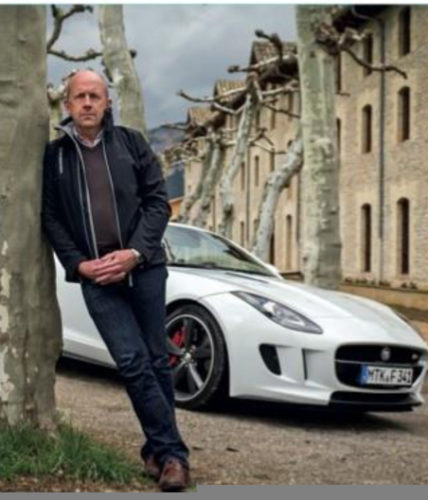
Mike Cross
Jaguar’s Chief Engineer
Vehicle Integrity
‘IT’S A PROPER SPORTS CAR but you could cross a continent in it. A proper jaguar in that respect’ says Mike Cross, Jaguar’s longstanding (since 2000) chief engineer, vehicle integrity, of the F-type coupe. That’s what he’s proudest of. ‘I didn’t drive the E-type during the F-type’s development, but what that car’s achieved was significant in evolving Jaguar’s dynamic DNA. It was a high-performance car but one that was capable of being driven long distances.’
That DNA theme is mentioned several times during our conversation and, when I mention the ‘family feel’ that’s common to Jaguar’s current range of XF, XK, XJ and now the F-type, Mike is pleased that I’ve noticed it. ‘We test for response at different speeds under different loads, so we have an objective measure of the car’s behaviour. The flavour is adjusted across the range: F-type is the most sporting, XJ the most comfortable. The steering is one attribute you use all the time. Its what makes you confident. We try to make Jaguars precise, immediate and intuitive – but not nervous.’
All of which goes to ensure a Jaguar, no matter how sporting, doesn’t become tiring when you drive it for a long time. And Mike puts in serious hours to make that happen. ‘When we launch a new car, a few of us drive the prototypes. I have a V8 R coupé that I commute in.’ And while he has a reputation for being seriously sideways – ‘it’s mainly something I do when working with the magazines’ – mostly he’s honing a car’s everyday capabilities and reactions, rather than its extremes. ‘Though,’ he admits, ‘if you can can drive like that, it suggests the car has inherent balance and agility.’
As for that E-type-like engine note? ‘We wanted the noise to be authentic, to relate to load and speed. The engine architecture is different but it has the same number of cylinders as an E-type…’
Words: Glen Waddington
Photography: Mark Dixon